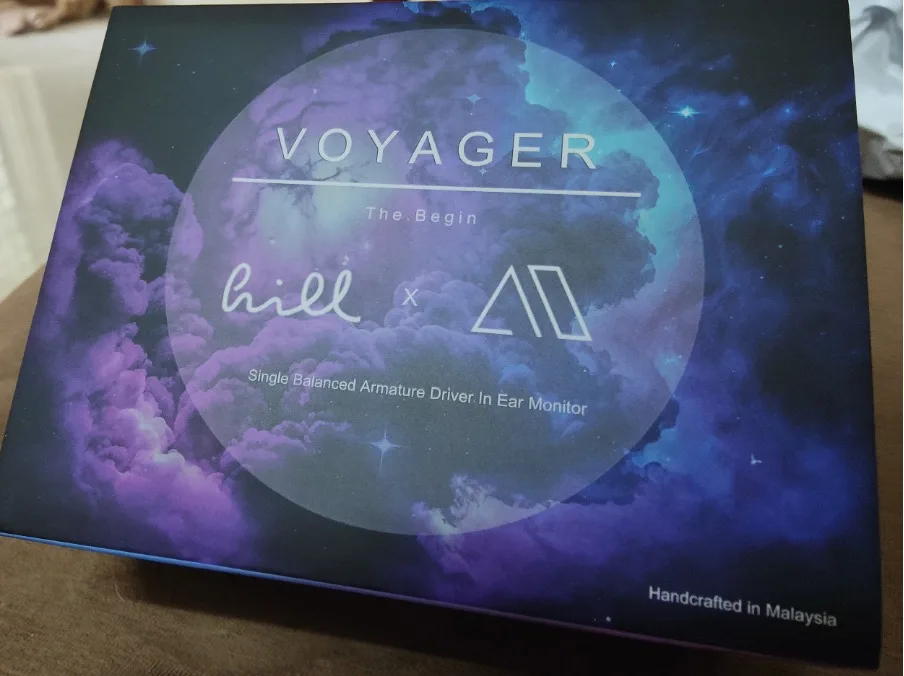Introduction
What do you get when you combine our own Malaysian made IEM company along with the most enthusiastic Malaysian online audio shop? The answer? The Hill Audio X Alpha Omega Voyager.
It’s been in the making for a while now and Vincent from Hill Audio has been teasing the product for a while with a combination of the talented IEM makers from Sarawak, Malaysia, Alpha Omega, to produce and sell a pair masterfully tuned single balanced armature, each with different tunings but with a price that your wallet will appreciate, thus the Voyager is created. Make no mistake that this is not your usual of the mill design, instead it is handmade by hand with a striking cosmos theme and I am certainly excited for this product. Hill Audio has sent us the Voyager pair, a HiFi version and the Bass version for an honest take. How will they fare? Let’s find out.
Functions & Specifications
Before we start the review, here are the specifications of the Voyager HiFi and Bass Version;
- Driver: Single custom full range balanced armature
- Shell: Handmade full resin shell
- Cable: 2 core silver plated OFC, 0.78mm(angled) to 3.5mm(angled) with microphone
- Frequency Range: 20hz – 20khz
- Impedance: 20 ohms
- Sensitivity: 118dB
Retail Price & Where to Get
The Hill Audio X Alpha Omega Voyager can be purchased at exclusively on Hill Audio shopee store :
Purchase Link : https://invl.io/clinl6b
Packaging & Accessories
Packaging of the Voyager is actually quite basic given the low pricing but what strikes me the most is the design art of the box as it is beautifully drawn with a dark purple cosmic theme. Inside we will find a basic 2 pin angled 0.78mm to 3.5mm cable, a fabric hard case, 3 pairs wide bore eartips in blue, 3 pairs of narrow bore eartips in green and both of them are actually quite comfortable and the IEM itself.
Design
Both of these in-ear designs are the same with unit designs varying from each other as it is hand made thus making each unit unique in a way. The HiFi version has some reddish hue to them making them
HiFi version

Bass Version

They are made from resin from moulding and they are polished neatly. They are small in size and super lightweight, thus giving a very comfortable fit. It doesn’t feel cheap on hand but they look and feel luxurious to be honest.

Both of these units are equipped with a custom tuned single balanced armature but what sets them apart is the presence of a crossover in the hifi version to provide a leaner, more accurate sound while the bass version is tuned to provide a warmer, bassier sound. Cable that the Voyager comes with is a basic 2 core, 2 pin 0.78mm cable with 3.5mm single ended termination. It is a silver plated OFC cable with a transparent sleeve. Pretty basic but if users itch for an upgrade, do visit the Hill Audio store as they are well known for bringing in superb custom order audiophile cables found nowhere else.

Gears Used for Comparisons
FiiO M17
Questyle M15
FiiO BTR7
TinHifi P1Max Panda
FloAudio Lily
Tangzu X SeeAudio ShiminLi Encounter
BQEYZ Winter
Hidizs MD4
Unique Melody 3DT
Dunu EST112
Songs list
Tone and Presentation
HiFi version
Tone of the HiFi Version is a diffused neutral signature IEM that is bright with a clinically clean and clear sound. They are a little thin sounding but they possess superb clarity, resolution and transparency. They are aggressive with an energetic attack in their mids and highs but never harsh sounding. They have little to none coloration in their presentation and have an accurate sound reproduction well suited for vocals and instrumental genres.
Bass version
The bass version is tuned towards a warmer, laid-back signature that has a slight emphasis on the lower mids making them a mild L shaped signature. They have a decent resolution and good detailings with an average transparency but they are indeed a relaxing signature that is fun to listen to. They also have a thick timbre and some colouration that is lusher and more intimate than the HiFi version. They are more suited for EDM, hip-hop, jazz and metal genres.
Soundstage
HiFi version
The soundstage in the HiFi version has an average soundstage with adequate width and height in their overall presentation. They do have some airiness in their extension and give a small headroom sized sound that doesn’t sound too boxy. They have a rather holographic soundstage that have good placements of sound that will suit gaming as well.
Bass version
The Bass version has a slightly better width and height versus the HiFi version and has better depth especially on the lower region. Airiness is slightly better on the HiFi version as the Bass version does lack some high range extension. Soundstage placements do sound excellent and have better placing of sound that is holographic and accurate as well.
Separation and Timbre
HiFi version
Separation on the HiFi version is actually superb and done pretty well with no crosstalk problems at all. They have a clean sound that doesn’t sound hazy or fuzzy in any genres. Their timbre is a little intense and they are slightly aggressive in their higher frequencies. No coloration is present here making them a clinical performer.
Bass version
Separation on the Bass version is also superb and has no crosstalk issues and will handle pretty much any genres you throw them at. They have a thicker timbre with a laid-back style of presentation making them a fun sounding IEM that have a less fatiguing sound in their high range. They do possess coloration here and on some music they might sound a tad bit inorganic but nothing really major here.
Drivability
Both of these IEM have similar specifications albeit different tuning signatures. They are rated at a 118db sensitivity with 20 ohms impedance and they are a sensitive IEM. Hiss and buzzing can be picked up on certain sources and due to the revealing nature of the HiFi version, they are more susceptible in these areas. They are quite picky with sources as a high impedance output player might induce buzzing and hissing but they are not picky with the sound signatures of the source. The HiFi version has the ability to pick up flaws present in music while the Bass version is more forgiving due to their tuning.
The Bass (Low)
HiFi version
Bass on the HiFi version has a flat signature that possesses a clean and clear bass response that is sharp and pure to listen to. Bassheads must most definitely avoid this version as they are indeed bass light and thin at times. The details and clarity here is amazing and everything sounded crystal clear with a tight bass slam without any bleed present. They do lack some body as they are mildly thin in nature but they do have a great texturing here. Sub-bass has a mild roll-off here but they are still able to have some rumbling presence here without sounding muted.
Bass version
The Bass version, as the name suggests, has a dynamic-esque authoritative bass response with a boost that has a thick, thumpy bass but still able to have a good degree of details and resolution here but clarity is mediocre versus the HiFi version. Though being strong in the bass department, they are not overpowered and able to suit most genres with minimal fatigue. Bassheads and fun signature users will find this tuning rather pleasant as they have an energetic bass with a respectable amount of bass impact. Sub-bass here is average in amount, but they have a deep rumble as well as decent extension here.
The Mids
HiFi version
The HiFi version midrange has a neutral to flat approach that has great transparency along with great details and clarity. They have an average resolution and do lack some thickness here but they are clinically clear and packed with detail in macro and micro regions, typical of a pure balanced armature driver. They do sound a little thin and lack some body but what they excel is their purity and they sound great in vocals and instruments genres. Female vocals sounded sweet and lush with great brilliance while male vocals sounded clear but lacked some depth with some deep voices. Instruments sounded accurate along with natural response but some bass instruments might sound a little thin but in a minor way.
Bass version
The mids on the Bass version have a more thick, slightly recessed midrange that manage sound neutral enough to provide good clarity and details all around. They are mediocre at best on their macro details but their micro details are actually great for their price with the capability to pick on minute sound in the music played. Resolution is also average but given their price, they are competitive enough. Vocals are a little recessed on female vocals as they do lack some top end brilliance while male vocals sounded superb as they are lush and intimate. Instruments sound great with a smooth sound and they are able to sound lush enough for most genres.
The Highs
HiFi version
The high range present in this version is a neutral bright high range that has a forward signature that has an energetic sound to them that possesses great detail retrieval capabilities as well as a good sense of clarity. They are slightly strong but not harsh on normal volume and they are not peaky nor shouty. They might not suit certain genres such as metal or Jpop as they might get too hot and fatigue might set in but amazing for vocals as they give music a little more life and brilliance. Sparkle is good with great air but what they do lack is some crisp decay in their extension. Treble here is on the more intense side but they are still accurate and natural without any metallic sound that is derived from some balanced armature set.
Bass version
The highs here have a different approach with a slightly recessed high range but still have good details and clarity. They are more suitable for treble sensitive users as they are tuned towards a smoother, laid-back style sound that is more forgiving in genre selection. They do have sparkle but on some female vocals, they lack brilliance and crispness. Treble here is well balanced between a mellow and intense which brings out the mids and bass region more. With this kind of treble amount, they are organic and free from any metallic sound typical of a balanced armature.
Comparisons
VS FloAudio Lily
The FloAudio Lily that we have recently covered is an up and coming new brand that has a high value versus performance index and the Lily is their second release. Equipped with a full range single balanced armature and they are slightly cheaper than the Voyager but the build quality and design on the Voyager is better
High range
Vs HiFi version
The HiFi version has better detail retrieval capabilities along with better clarity and a livelier sparkle. Amount of energy is also bigger on the Voyager versus the smoother sounding Lily.
Vs Bass version
They both have a very similar approach with a relaxed, slightly recessed high range that is smooth and inoffensive. Details and clarity is slightly better on the Voyager. Sparkle on the Voyager is more evident as well.
Midrange
Vs HiFi version
The Voyager has a brighter approach with better transparency and a slight edge in detail. The Lily has a thicker sound that is more lush and intimate but slightly closed.
Vs Bass version
The Lily sounds thicker in a minor way but the details and clarity is better on the Voyager especially in the micro details as well as separation. Lily has better texture but lacks width like in the Voyager.
Bass
Vs HiFi version
Amount of bass on the Lily is more with a more dynamic-esque type of bass response. The Voyager bass is thinner and sharper and the sub-bass extension on the Lily is better. Voyager bass has a purer feel to them while the Lily has a more energetic, fun type of bass.
Vs Bass version
They are similar here but the bass on the Voyager is clearer with more details. Sub-bass on the Lily extends deeper with a more evident slam.
Soundstage Both versions of the Voyager’s soundstage are slightly wider and taller than the boxy sounding soundstage of Lily.

VS Tangzu X SeeAudio ShiminLi Encounter
A recent collaboration between 2 famous audio companies from China with a single dynamic driver that sounds pretty decent for the price range which is almost double the asking price of the Voyager. The Encounter is a full metal body IEM with a blood moon red.
High region
Vs HiFi version
The highs on the Voyager are slightly stronger with a tad bit more detail while clarity is the same. Encounter highs are smoother with a crisper and better sparkle. Air on both are similar.
Vs Bass version
The Voyager highs sound more recessed and laid-back. Details and clarity on the Encounter is better with a slight edge in their airiness, sparkle and crispness.
Midrange
HiFi version
The voyager has the edge in details and clarity while the Encounter has a thicker, more forward presence along with a lusher presentation. Vocals on the Encounter has a more intimate feel to them while the Voyager is a little too clinical.
Bass version
The mids on both are quite similar with a thick and intimate presentation but the Voyager seems to sound a tad bit clearer while the Encounter has better resolving capabilities.
Bass
HiFi version
The Encounter bass has the edge in quantity and quality as usual of a dynamic driver versus the rather thin and flat bass of the Voyager. Sub-bass extend deeper on the Encounter but the Voyager bass sounds a little clearer.
Bass version
The bass of the Encounter has a slight more authority in their slam but they are close. Bass texture on the Encounter is better and the sub-bass reaches deeper but clarity on the Voyager is better. Both have immersive bass but the dynamic driver bass on the Encounter is slightly more energetic overall.
Synergy
Questyle M15
The Questyle M15 is my favourite dongle DAC/amplifier of all time as they sounded really sublime as they are very well built with Questyle’s signature direct current amplification and I have been a true fan of this dongle since the day it was launched. They are a neutral to bright sounding device for a portable usage with a great extension on both ends.
For the HiFi version, the bass has a better, tighter impact with added sub-bass depth while the details and clarity doesn’t see much changes. As for the bass version, bass response is clearer and cleaner with more details and clarity.
Midrange on the Hifi version is clearer with added resolution while transparency and thickness remains mostly the same. Vocals sounded slightly lusher with cleaner vocalisations. The bass version also has improvements in their clarity and details with better resolving capabilities and transparency. Vocals are cleaner and lushness is kept along with their intimacy.
High range of the Hifi version is more polished, thus reducing their harshness. Details and clarity remain the same but they are slightly cleaner. Sparkle is cleaner and crispness is added by a tad bit. The HiFi version has an improvement in their brilliance, clarity and details but they are still recessed. They sounded livelier than usual and the smoothness quality was kept.
Soundstage has seen improved depth, width and height but it is not very significant as their scalability is quite low and they are easily driven by any source, which can be a good thing for some users that want ease and portability.
Who Is It For?
The Voyager pair is very well suited for beginner audiophiles or even seasoned users that wanted a pure balanced armature sound that has all the transparency qualities of balanced armature driver without any major timbre problem that derives from a low quality driver. They are priced at a low price and they do not skip on their build quality as well, thus suitable for daily usage or even workouts. Gamers will also find both this set useful as they are highly resolving for games such as FPS. And for treble, details freaks, the HiFi version is for you while the Bass version will suit light bassheads who want an immersive sound but they are not for hardcore bassheads as they have only an adequate strong rumble.
Final words
The teasing of this Voyager set has been a nerve wracking wait for me as they looked superb with their cosmic theme, CIEM style shell and they are a true eye candy. What’s more shocking is their price at rm119 that comes in 2 different sound styles for your choosing, which is honestly a steal and people who know portable audio stuff knows what I am talking about. With a proven high quality balanced armature driver that is tuned well, we can be sure they provide top notch transparency, details and clarity which is typical of that driver and the Alpha Omega X Hill Audio Voyager surely have achieved their goal in providing this superb value product that ticks most of the box in their performance. I really do hope that they will continue on this great voyage. A job very well done guys!
I would rate this product 4 and a half over 5 stars
HiFi version
Pros
- Amazing value
- Superb design and build
- Snug fit Comfort
- Great transparency
- Great detail retrieval and clarity
- Pure uncoloured sound
- Amazing vocals
- Accurate timbre
- Brilliance
- Clean midrange
Cons
- Lack sub-bass extension
- Slightly thin mids and bass
- Mediocre soundstage
- Slightly lacking in crispness
- Might be too clinical at times
Bass version
Pros
- Amazing value
- Superb design and build
- Snug fit Comfort
- Thick, fun overall signature
- Immersive sound
- Amazing bass response
- Thick, lush midrange
- Smooth, inoffensive high range
- Good micro details
- Natural sub-bass
- Fatigue free laid-back sound
Cons
- Slightly recessed high range
- Macro details a little average
- Lack brilliance in highs
- Lack crispness
- Mediocre soundstage but slightly better than the HiFi version
Ratings
Tone and presentation : 8 out of 10
Build and design : 10 out of 10
Separation and timbre :
HiFi Version : 9 out of 10
Bass Version : 8 out of 10
Soundstage :
HiFi Version : 7 out of 10
Bass Version : 7 out of 10
Bass :
HiFi Version : 7 out of 10
Bass Version : 8 out of 10
Midrange :
HiFi Version : 8 out of 10
Bass Version : 8 out of 10
Highs :
HiFi Version : 8 out of 10
Bass Version : 7 out of 10













